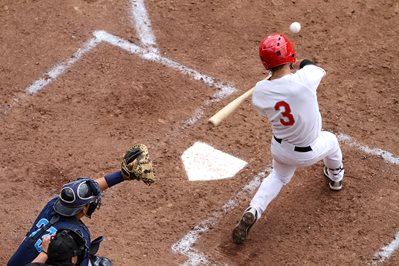
Major League Baseball (MLB)—America’s national pastime and oldest professional sport—is setting a new standard in the world of sports by recognizing and supporting athletes who contend with mental health conditions.
For decades, the stigma surrounding mental illness has discouraged professional athletes and ordinary fans alike from seeking help. Stigma runs especially deep in the professional sports world, where athletes are celebrated for their seemingly superhuman physical talents and unshakeable mental focus.
While baseball players historically have been expected to tough out their problems, dust off their mitts and get back out on the field, Pablo S. Torre of Sports Illustrated reports that MLB is paving the way for players to get help and return to the game in his June 2010 article, “A Light in Darkness.”
Under Pressure
Even as a team sport, baseball is a game that fosters considerable pressure on individual performance. It’s not hard to imagine how an off day for a pitcher or a hitting slump for a fielder can be magnified under the bright lights of a stadium filled with tens of thousands of fans.
And then there is all that time on the road, traveling for 81 away games in a season. There’s too much time to reflect on or obsess about shortcomings, and too little time in the company of family and friends who can offer perspective and support. Isolation from these support systems can also engender its own stresses and conflicted emotions. Players on the road may try to suppress feeling of anxiousness or depression, reluctant to confide in a teammate or get help, exacerbating their situation. The stakes are bigger than wins and losses and renewed contracts.
Early intervention and treatment are keys for success in managing any illness, including mental health conditions. Players who do not get adequate treatment and support are at risk for failed relationships, broken families, other related health problems and even suicide.
MLB: From Silence to Support
During the 2009 season, five players were on the disabled list (DL) for emotional issues, the most in any single MLB season to date; however, many players secretly struggled with mental illness over the years, during a time when baseball executives were likely to either dismiss such issues or ignore them.
One exception was Jimmy Piersall, an outfielder with teams including the Boston Red Sox, the Cleveland Indians and the New York Mets during the 1950s and ’60s. In 2008, The Advocate profiled Piersall, who lives with bipolar disorder. The two-time Golden Glove winner and all-star player was perhaps best known by fans for his colorful behavior on the field such as fights with other players and stunts like running around the bases backwards.
Piersall had a family history of mental illness, and some of the entertaining antics fans most enjoyed were manifestations of his bipolar disorder. Following electroshock therapy in 1952, he believed his career was over, but instead he received tremendous support from both his teammates and fans. Piersall returned to the Red Sox in 1954 and shared his story with local television and the Saturday Evening Post, a bold move during a time when few spoke about such experiences with extended family or friends, nevermind the American public. He also wrote an autobiography, Fear Strikes Out: The Jim Piersall Story, in 1955, which was made into a movie.
While Piersall’s candor challenged stigma, it did not translate into an immediate, marked difference in MLB or public attitudes about mental illness. However, in the decades since, there has been progress.
In 1981, the MLB commissioner’s office introduced Employee Assistance Programs (EAPs), which are designed to help employees and their family members manage personal problems that may affect their work performance. Initially, EAPs were largely focused on substance abuse in baseball, but today players can get support and guidance on a broad continuum of issues related to mental health. EAP consultations may involve a medical evaluation or counseling, or other referrals for continued help.
Dontrelle Willis, then a pitcher with the Detroit Tigers, was one of the players placed on the disabled list for emotional disorders during the 2009 season, and following his public acknowledgement of an anxiety disorder diagnosis, Torre reported that MLB instituted a new protocol outlining DL criteria for emotional disorders.
Each MLB team received a memo outlining DL regulations, specifying that in order for a player to make the DL for an emotional disorder, he “must be evaluated and diagnosed by a qualified mental health professional as suffering from a mental disability that prevents a player from rendering services.”
Rather than denying or hiding mental health conditions, players can now take time off to get the help they need, through their team franchise and elsewhere, much as they would in the past for any other physical injury or illness. While relatively few players have stepped forward, the growing number is encouraging and suggests that players are now more comfortable seeking help than in the past.
Returning to the Mound
If anyone is the poster child for the merits of mental health treatment and the success of recovery, it may be Zack Greinke of the Kansas City Royals, the reigning American League Cy Young Award Winner.
As a senior at Apopka High School in Florida, Gatorade honored him as National High School Player of the Year after he struck out 118 batters and boasted an .55 ERA. Following high school, he transitioned easily to the minor league, finishing the season with a 15-4 record and a 1.93 ERA.
As a 20-year-old joining the majors in 2004, Greinke threw a 95 m.p.h. fastball and had enviable control. During that rookie year, he was named Royals pitcher of the year, the youngest player to receive the honor in the history of the team. But the 2005 season was humbling, dramatically different. He finished the season with a 5-17 record and a 5.80 ERA. Greinke’s relationships with his pitching coach and other teammates were strained; he questioned his ability as a pitcher and became more withdrawn.
Greinke was so overwhelmed when he returned for the 2006 spring training that he struggled to pitch a single strike in one bullpen session, and again in the following session. He was battling a severe depression, worsened by stresses triggered by his poor performance. It was during this time that he made the decision to walk away from baseball to get a handle on the life and career that were unraveling. At age 22, he missed nearly the entire 2006 season.
It was during this break from baseball that Greinke was diagnosed with social anxiety disorder, an extreme fear of being scrutinized and judged by others in social or performance situations. Greinke is not alone; approximately 15 million American adults live with social anxiety disorder, but he is unique in that his career involves routinely performing in high-pressure games before tens of thousands of people
During his break from baseball, Greinke had time to learn how to best manage his social anxiety disorder and depression using a combination of medication and therapy. In 2007, he returned to the Royals, stronger and more focused.
“I felt really good about it, like things were coming back. Not just to where I pitched last year, but where I pitched a while ago,” Greinke told Sports Illustrated in 2007. “I still have a long way to go. But it was just a good feeling … that I feel like I know what to do.”
Greinke worked his way back to the top of the pack and had a banner year in 2009, winning the American League Cy Young Award and marrying his high school sweatheart, Emily Kuchar, a former Dallas Cowboy cheerleader.
Greinke won the American League Cy Young Award in a landslide victory over Felix Hernandez of the Seattle Mariners, earning 25 of the 28 first-place votes. He finished the 2009 season with a 16-8 record and a 2.16 ERA, the lowest in the American league in nearly a decade and a long way back from the 2005 season.
Though Greinke doesn’t see himself as a role model for mental illness and treatment, Pablo Torre reported that this spring Greinke remarked, “This medicine is unbelievable. I’m still the same person, but my attitude about everything is different.”
The same can be said about Major League Baseball: it is the change in attitude that ultimately will make all the difference in supporting players who can get help, return to baseball and reach their full potential.

